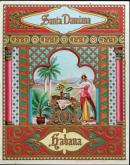LITHOGRAPHY. The Paper that Spruces Up Cigars
FACES OF WORLD PERSONALITIES DEDICATED TO DIFFERENT ACTIVITIES HAVE BEEN LINKED TO THE CREATION OF HABANO BRANDS, DEPENDING ON THE MARKET THEY ARE MEANT TO PRY INTO
Bands always bear the Habano brand name printed in paper or carry in the middle, in a circle, the faces of the characters used in the labels or other decorative elements. It’s our belief that the use of bands started fully back in the 1870s or 1880s with the so-called brandings or labels that were used to cover the cigar boxes, as well as each and every Habano in particular.
Faces of world personalities dedicated to different activities have been linked to the creation of Habano brands, depending on the market they are meant to pry into, either in Europe, the U.S. or the rest of the Americas. There are good cases in point, like the ones dedicated to Queen Victoria and her son, King Edward VII of England, or Spanish King Alfonso XIII, who is depicted in several moments of his lifetime. Other interesting characters are Venezuelan freedom fighter Simon Bolivar, U.S. President Franklin D. Roosevelt and British Prime Minister Winston Churchill during World War II, a deep-rooted Habano smoker.
It was also commonplace to stamp the names of places on the bands, such as associations, fancy clubs, different events –like baseball games, horse races, theater plays and the like.
Every so often, the art of lithography is associated to tobacco. Perhaps few people know this linkage was born out of music as far back as 1822, when a Frenchman named Santiago Lessieur y Durand opened a workshop to reproduce music scores in a newspaper called “The Musical Journal”, a joint publishing effort with Spanish musician Enrique Gonzalez.
Let’s not forget that tobacco endured a century-old embargo in Cuba (1717-1817), and therefore it was only sold to Spain through three different seaports just to feed the necessary raw material for the former Seville factory. That prompted a surge in tobacco smuggling, with Cuban and foreign vessels scouring the island nation’s coasts as the use of tobacco in Europe was clearly on the rise in a variety of ways: snuff, rape, in carrot-shaped containers full of tobacco powder and as rolled cigars in a multitude of forms and sizes –they eventually gave birth to the name vitola. Each and every Habano could be told apart for both their thickness and specific size.
Habanos were named after the port where they used to be shipped overseas: the port of Havana. They were packed depending on the vitolas, in boxes or cases made of cedar and with labels glued on the top containing the following information: brand name, a drawing of an image that sometimes stood for the name of the brand, the name of the factory and the owner, the factory address and, above all, the keyword: Havana, indicating the origin of the very best tobacco grown and manufactured in the whole world.
More labels popped up as time rolled on in a bid to stave off forgery and imitations around the globe against the major outputs coming out of the Cuban factories. Some major standouts back then were hierro, vista, bofeton, papeleta, tapaclavo, filetes and anillas (bands).
This much brings to mind the verses of Cuban poet Gabriel de la Concepción Valdés (Placido), who was executed by a firing squad in 1844, entitled “The Sugarcane Flower”, in which he describes two lovers in a countryside dance and how they let each other know about their love:
A cigar
From Manicaragua
With a lovely band
That fits the wrapper,
And instead of a filler
I found her letter
For me more beautiful
Than the sugarcane flower
Bands have been precisely one of the best-known, most sought-after and collectable-prone labels throughout history, not only because of their function, but also due to its location around the cigars.
One particular band is the one that carries the image of the Virgen de la Caridad del Cobre, Cuba’s patron saint. This one clearly illustrates the mixture of all those stories and realities that round out Cuban tobacco’s grandiloquence and autochthonous character. This is no doubt a combination of art and tradition, the identity of a nation whose history is incomplete without mentioning one of its most representative elements: the Habano.






























